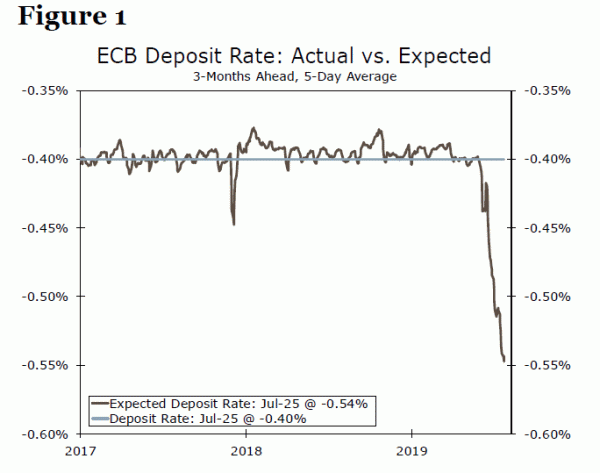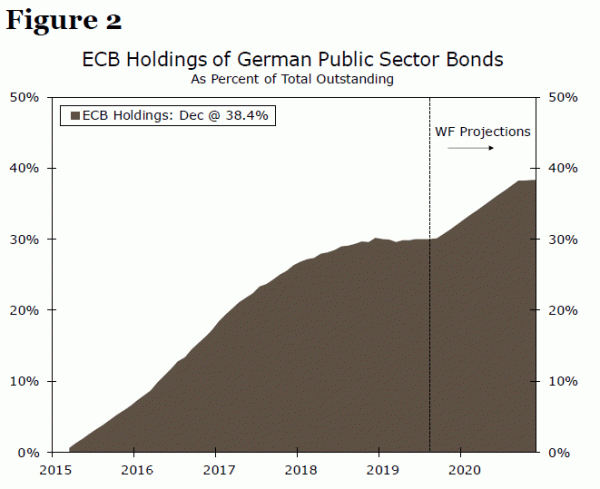Executive Summary
- The ECB held policy steady today but sent strong signals on easing measures likely to come in September. An ECB rate cut in September is all but certain now—the only question is how large—and we now expect the ECB to restart its QE program.
- We think the ECB will buy €45B of sovereign bonds per month for 12 months starting in October. That will almost certainly require the ECB to raise its issuer limits for sovereigns to 50% from 33%. We are not expecting the ECB to buy corporate bonds or equities.
- We are not making any changes to our GDP and CPI forecasts for the Eurozone as a direct result of these changes, and instead will wait for upcoming data—including Q2 GDP— before assessing whether changes to our economic forecasts are warranted. Today’s ECB announcement could restrain the euro in the short term, although with the Fed also easing policy, we still see room for some euro recovery over time.
Draghi Tees Up the ‘Package’
The European Central Bank (ECB) announced monetary policy today, and while it made no immediate changes to interest rates or other tools, it set the stage for a broad package of easing measures at its next meeting in September. First, the statement noted that key interest rates would remain at present levels or lower at least through the first half of 2020, with the addition of ‘or lower’ signaling a near-term rate cut is likely on the way. As a reminder, we expect the ECB to cut interest rates 10 bps at the September meeting. At this point, a rate cut in September is nearly a sure thing, as media reports after today’s announcement suggest ECB policymakers view a cut in September as certain. One area of uncertainty is whether the ECB may opt for a 20 bps rate cut instead of just 10 bps—markets are pricing in more than 10 bps of rate cuts by October (see Figure 1 on following page).
The ECB also opened the door to additional easing measures, as it said authorities are examining potential new net asset purchases as well as a tiering system for commercial bank reserves and changes to forward guidance. Reinforcing that view were comments from ECB President Draghi in the post-meeting press conference that ‘we don’t like what we see on the inflation front.’ He also noted that the economic outlook is getting ‘worse and worse.’ To be sure, it was not all gloom—Draghi also noted that the risk of recession was relatively low. However, even in the absence of recession, the persistent weakness in Eurozone growth and inflation, in the context of today’s ECB statement and comments, suggests the ECB is likely to deliver a broad package of easing measures in September.
What’s In the Box?
With a rate cut from the ECB in September more or less a given at this point, the question is, what other measures might the Governing Council (GC) announce and implement, if any? We had previously not expected the central bank to restart its QE program, partly because of the potential political, legal and practical challenges associated with buying more assets. Perhaps more importantly, we felt that the inflation outlook, both in terms of actual inflation and inflation expectations, was not dire enough to justify renewed QE at this time. However, today’s ECB policy announcement suggests that policymakers are more concerned about the inflation outlook, and moreover, we note a key change in the central bank’s signaling around its inflation goal. Specifically, the ECB’s statement noted that ‘the GC is determined to act, in line with its commitment to symmetry in the inflation aim.’ The central bank’s inflation target of ‘below, but close to, 2%’ is by its nature not symmetric around 2%, but the mention of symmetry suggests the ECB may be more comfortable with, and indeed possibly even pushing for, inflation above 2%. This strong signaling on inflation in our view suggests that a new QE program will be announced in September.
The parameters of any possible QE program from the ECB are hard to determine with precision, but we note a few key points:
- Timing: Announced in September, but implement actual purchases starting in October
- Amount/Duration: €45 billion per month for 12 months, or €540 billion in total purchases, with the possibility of being extended
- Composition: Sovereign bonds—not expecting corporate bonds or equities to be included at this time
Among the most pressing issues the ECB will need to contend with in implementing new asset purchases is the self-imposed issuer limits, which currently prevent the central bank from purchasing more than 33% of any issuer’s stock of eligible debt. By our calculations, the central bank already owns just over 30% of German sovereign debt securities, suggesting that renewed asset purchases would require a change to the issuer limits. The most likely change is, in our view, for the central bank to simply raise the issuer limits, perhaps to 50%. If the ECB implements new asset purchases in line with the amounts we expect, our calculations suggest the share of German government debt owned by the ECB would rise to around 40%, far enough below 50% that it gives the central bank some wiggle room if it wants to extend the duration of or increase the amount of its purchases (Figure 2).
What about other measures? The ECB has explored implementing a tiering system for commercial bank reserves, aimed at mitigating the side effects of negative interest rates on banks in the Eurozone. However, in light of comments from ECB policymakers on the matter thus far, there appears to be too much opposition among policymakers for the central bank to implement such a system at this time, and indeed we are not expecting such a system to be put into place. In terms of the amount and duration of any purchases, the central bank is likely to choose these parameters such that any purchases are sufficiently large to have a meaningful economic impact but not so large that it reduces policy flexibility. Purchasing €45 billion per month of sovereign bonds would increase the ECB’s holdings around 25%, a fairly substantial increase, but would also allow for the central bank to ramp up (or reduce) purchases down the road if needed (recall that the ECB initially purchased €60 billion per month in bonds when it first launched QE in 2015, and increased to €80 billion per month in 2016). For now, we do not expect corporate bonds to be included in any new QE program, as financing conditions for Eurozone corporates appear to be more favorable than in early 2016 when the ECB first implemented corporate sector purchases. Meanwhile, we are not expecting equities to be included, considering the likely political and practical challenges and apparent resistance from ECB policymakers.
What about other measures? The ECB has explored implementing a tiering system for commercial bank reserves, aimed at mitigating the side effects of negative interest rates on banks in the Eurozone. However, in light of comments from ECB policymakers on the matter thus far, there appears to be too much opposition among policymakers for the central bank to implement such a system at this time, and indeed we are not expecting such a system to be put into place. Accordingly, in September, we are expecting the ECB to implement a 10 bps cut to its deposit and refinancing rates and announce a new QE program, but refrain from additional policy measures.
Conclusion
The ECB sent fairly strong signals today that a broad package of easing measures is likely to be delivered in September. A rate cut is highly likely, while we also now expect the central bank to announce a new program of asset purchases focused on sovereign bonds. In all, today’s developments reflect the broader theme of global central banks—not just the Fed—shifting in a more dovish direction, a theme which factors into our view of a soft landing for the global economy. Meanwhile, turning to the euro, we think the single European currency will remain on the defensive for now, but we still think it can recover gradually against the greenback over the longer term.















